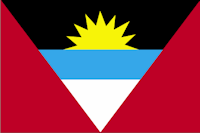Antigua & Barbuda - People
 The U.S. government estimates the total population at 92,000 (July 2015 estimate). Antigua considerably dominates Barbuda in population (58,114 to 1,241 in 1991) and is nearly twice as large (108 to 62 sq. mi.).
The U.S. government estimates the total population at 92,000 (July 2015 estimate). Antigua considerably dominates Barbuda in population (58,114 to 1,241 in 1991) and is nearly twice as large (108 to 62 sq. mi.).
The 1991 Census, the first complete census to be conducted in Antigua-Barbuda since 1960, enumerated a total population of 59,355, with 58,114 persons in Antigua and 1,241 in Barbuda. This count, based on all persons residing in the two islands on census night (May 28, 1991) regardless of citizenship, was 22,000 to 25,000 persons less than estimates made by the Department of Statistics and various Government Ministries. The unexpected low 1991 Census count prompted a lot of debate in Antigua regarding the conduct of the census and the usual enumeration problems.
According to the 2011 census, 17.6 percent of the population is Anglican; 12.4 percent Seventh-day Adventists; 12.2 percent Pentecostal; 8.3 percent Moravian; 8.2 percent Roman Catholic; and 5.6 percent Methodist. Those having unspecified or no religious beliefs account for 5.5 percent and 5.9 percent of the population, respectively. Members of the Baptist Church, the Church of God, and the Wesleyan Holiness Consortium each account for less than 5 percent. The census categorizes an additional 12.2 percent of the population as belonging to other religious groups that together constitute less than 2 percent of the population and include Rastafarians, Muslims, Hindus, and Bahais.
The Caribbean Rastafari Organization stated that the government’s prohibition of marijuana contradicts their religious rights because marijuana is integral to their religious rituals. Rastafarians disagreed with the public school requirement that children be vaccinated, which they state is against their religious beliefs. They also said the requirement to remove their headdress for passport photos and at security checkpoints was an additional infringement of their religious rights.
Rape is illegal and carries maximum sentences ranging from 10 years to life imprisonment. The government was unable to provide the number of persons prosecuted for unlawful sexual intercourse, but anecdotal evidence suggested it was a pervasive problem. Violence against women, including spousal abuse, continued to be a serious problem. The law prohibits and provides penalties for domestic violence, but some women were reluctant to testify against their abusers due to fear of stigma, retribution, or further violence. Adult men having sexual relations with girls as young as eight years of age was also a problem.
According to the 2001 census, the population stood at 76,866. The projected population for 2010 was 90,801, with 42,642 males and 48,159 females. The general fertility rate has fluctuated from year to year; in 2010, it stood at 51.75 per 1,000 women of childbearing age (see Table 1). Life expectancy at birth in 2010 was given as 77.4 years for females and 73.3 years for males. During 2006–2010, the crude birth rate varied from 14.22 per 1,000 population in 2006 to 13.82 in 2010. The crude death rate was 5.82 per 1,000 population in 2006 and 4.86 in 2010. The annual population growth was estimated to be 1.3% in 2010.
Based on 2010 mid-year population estimates, approximately 98% of the country’s population lived in Antigua, and 32% lived in rural areas. The country experienced both inward and outward migration. It is worthwhile to note that in 2010, an estimated 20,900 persons (23.6% of the population) immigrated to Antigua and Barbuda, mainly from Dominica, Guyana, Jamaica, and the United States (2). Economic wealth and close proximity to developed countries are some of the attractive features that draw low-skilled workers to the country.

|
NEWSLETTER
|
| Join the GlobalSecurity.org mailing list |
|
|
|

